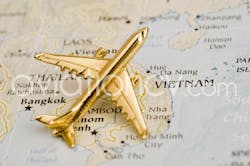Over the past several years aviation industries in China and several other NICs in Asia have been absorbing the main market and media attention. Their unprecedented growth rates and prodigious ambitions have conquered the minds around the world. Meanwhile, it seems that the global air transport industry is witnessing the rise of another aviation tiger, stretched along the South China Sea.
“Back in 2011 our colleagues in IATA forecasted that in three years’ time Vietnam will become the world’s third fastest growing aviation market. The figures we see today clearly show that there is no reason to doubt the legitimacy of such expectations. In certain segments, Vietnamese aviation is growing even faster than the Chinese one!’ comments Skaiste Knyzaite, the CEO of AviationCV.com.
According to the data provided by the local aviation and tourism authorities, in 2012 the growth of international air passenger traffic in Vietnam reached approx. 10.8%, while in China the international air travel market increased by 10.3% only. As concerns the domestic routes, Vietnam expects to double the growth rates to approx. 7% compared to 2012.
Despite being rather unexpected, the rise of yet another Asian aviation market ‘tiger’ was certainly predictable. Following the scenario observed in other countries within the region, the development of the air travel market is being backed by both the increasing FDI and the continuous strong growth of the middle class in the country. According to local authorities, during the past 10 years the purchasing power of Vietnamese has increased almost four times – from approx. 27.5 billion to 99.3 billion USD.
In the meantime, despite the rapidly improving economic situation, the labour costs in Vietnam remain quite low compared to other neighbouring Asian countries. It encourages international companies, mainly from the segments of telecommunications and IT, to invest and establish local manufacturing facilities in Vietnam. As a result, in 2012 the revenues from the export of cell phones, computers and relevant parts accounted for almost 18% of the total value of the entire national export (approx. 114.5 billion USD). Moreover, according to ASEAN Business Outlook Survey, Vietnam still remains one of the most popular destinations for expansion inside the ASEAN region. Naturally, the growing activity of foreign companies supports the strong development of air transport in Vietnam, as air travel remains the main mean of reaching the country from other regions – during the first 9 months of 2013 over 79% of international visitors came to Vietnam by air (Vietnam National Administration of Tourism).
“This entire economic boom has caused a splash in the local aviation industry. Though the industry is rather small, with only several local air companies currently occupying the market, their ambitions are growing fast. Jetstar Pacific are planning to receive extra 10 Airbus A320s in two years’ time. VietJet is expecting over 90 new Airbus deliveries and Vietnam Airlines, the flag carrier, is planning to expand its fleet to almost 120 aircraft in the following few years. Though local airlines mostly prefer Airbus (probably due to historical ties of Vietnam and Europe), other mainline and regional aircraft are increasingly gaining popularity,” comments Skaiste Knyzaite.
Meanwhile, the growing potential of Vietnamese air transport didn’t go unnoticed by other regional airlines. According to the Diio Mi data, the largest carriers connecting Vietnam with the rest of the world include (apart from the national flag carrier Vietnam Airlines) such foreign giants as AirAsia, Thai Airways, Singapore Airways and others. And the competition posed by foreign carriers from South Korea, Japan, Singapore, Russia, Taiwan, China and Europe keeps getting tougher.
“While the national training industry is still developing, Vietnamese carriers are continuously looking for staff from across the entire region. Today approx. 500 expats are already flying for Vietnamese companies. Local carriers are eager for experienced personnel as it is the only way they can ensure further development of their fleets. Considering the competition in the regional job market, Vietnamese employers are also forced to keep higher salary rates for foreign pilots in order to compete with airlines from China, Malaysia or Indonesia. At the same time, it seems that Vietnam might also create extra opportunities for bizav pilots. As a result of intense penetration of foreign companies to the local economy, the number of business tourists in Vietnam has more than doubled in the past eight years, giving the floor to the development of corporate and private aviation in the country,” concluded the CEO of AviationCV.com.
About AviationCV.com:
AviationCV.com, part of aviation business group Avia Solutions Group, is the only pilot leasing company in Eastern Europe and the Baltic states. It offers flight crew resourcing and training/retraining as well as short-term and long-term crew lease services to airlines in Europe, Asia and the Middle East. For more information about AviationCV.com please visit www.aviationcv.com.

